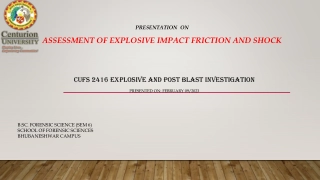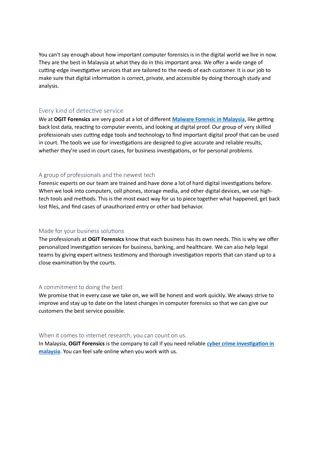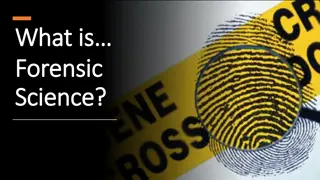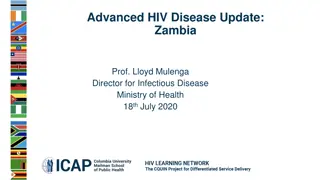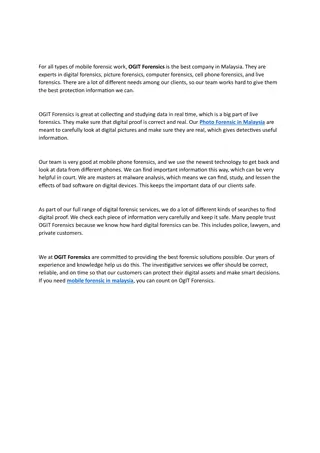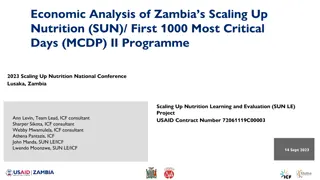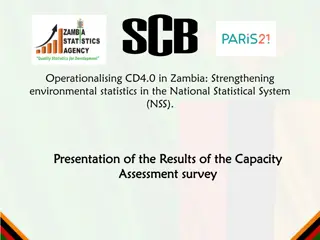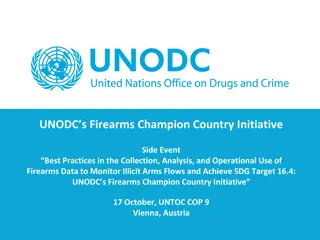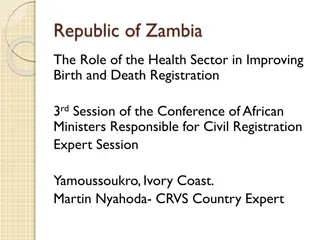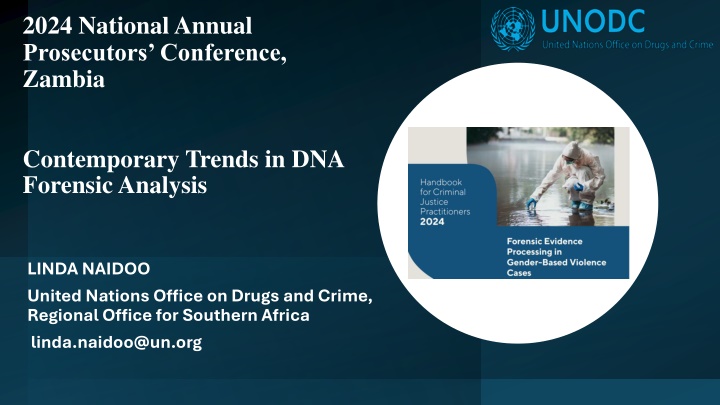
Advancements in DNA Forensic Analysis: Impact and Case Studies
Explore the significant impact of DNA databases on solving crimes through a compelling case study of a serial rapist apprehended using forensic evidence. Discover the challenges in current forensic service provision, reporting, and evidence collection in the realm of law enforcement and criminal justice.
Download Presentation

Please find below an Image/Link to download the presentation.
The content on the website is provided AS IS for your information and personal use only. It may not be sold, licensed, or shared on other websites without obtaining consent from the author. If you encounter any issues during the download, it is possible that the publisher has removed the file from their server.
You are allowed to download the files provided on this website for personal or commercial use, subject to the condition that they are used lawfully. All files are the property of their respective owners.
The content on the website is provided AS IS for your information and personal use only. It may not be sold, licensed, or shared on other websites without obtaining consent from the author.
E N D
Presentation Transcript
2024 National Annual Prosecutors Conference, Zambia Contemporary Trends in DNA Forensic Analysis LINDA NAIDOO United Nations Office on Drugs and Crime, Regional Office for Southern Africa linda.naidoo@un.org
A meeting of Science, Law & Technology 2
IMPACT OF DATABASES Finger, DNA, ballistics, genetic genealogy databases
Case Study: Leashing a serial rapist Mki, a 34 year old male was charged with several offences, committed between 2011-2015. The accused conducted a reign of terror over a 4 year period. During evenings, mornings he would target victims, grab, & threaten them at knifepoint, demand money, cellular phones. He would then proceed to an isolated place & rape them. Beating the victim into compliance, by punching them, or stabbing, to prevent resistance. Some victims were raped more than once. 9 of his 30 victims were children under the age of 16, with the youngest victim @ 11 years. The breakthrough in the investigation occurred, when Mki was arrested and convicted for an unrelated charge of assault in 2014, for which he subsequently served 11 months imprisoned. 4
Case Study: Leashing a serial rapist While serving his sentence, in custody, and in terms of the legislation pertaining to DNA, law enforcement were mandated to collect DNA samples from all convicted offenders, retrospectively, and run the resultant DNA profile through their National Forensic DNA database, for a comparative search against all other indices, including the crime scene index which in this case contained the forensic DNA profiles of an unknown male in 30 separate rape cases. There was a match! Mki was linked to the 30 unsolved rapes; due to the DNA sample obtained as a result of an unrelated conviction for common assault. Due to the overwhelming DNA evidence against the accused, Mki pleaded guilty to 84 charges which included 30 counts of rape, 27 of kidnapping, 12 of robbery with aggravating circumstances, and four of assault with intent to cause grievous bodily harm. Mki, was ultimately sentenced to 15 life terms, and an additional 120 years, to run concurrently. Without the power of the NFDD and the DNA legislation which allowed DNA samples to be collected from the accused whilst he was serving time, as a convicted offender; it is unquestionable that Mki would have continued his reign of terror. By linking Mki to his crimes through the NFDD, potential, vulnerable victims were saved.
Challenges in Current Service Provision, Reporting, and Collection of Forensic Evidence Lack of coordination & collaboration between stakeholders Training!!!! For everyone Procedures & Documentation & Resources Legal framework Maintain a proper chain of custody- preventing contamination Database Expert witnesses & report writing
2024 UNODC SADC Handbook on Forensic Evidence in Gender based Violence
Chapters 1-7 [C1] Context of GBV [C2] Context of sexual exploitation of women and girls during humanitarian crisis paternity disputes and maintenance claims [C3] Introduction to forensic science and its value in GBV cases [C4] Response & management - Preservation of evidence [C5] Maintaining the chain of custody of evidence [C6] Quality assurance processes in forensic science [C7] Dealing with mixed profiles in GBV cases 9
Chapters 8-14 [C8] Use of forensic intelligence databases (DNA/ Fingerprints/ballistics) in GBV [C9] Maximizing the evidentiary value of DNA: From STRs to Forensic Investigative Genetic Genealogy [C10] Interpretation and evaluation of forensic evidence [C11] Assessment of the credentials of forensic experts & expert testimony [C12] Presentation of forensic evidence in the courtroom [C13] Guidance on the communication of forensic evidence in media [C14] Forensic science capacity development 10
Forensic evidence begins at the crime scene MY BODY IS A CRIME SCENE! Linkage between the victim & offender is crucial!! Ask: What!! How!! Interrogate the situation to put the pieces together! Evidence credibility equipment, personnel, process, trained, documentation Internal and external examination items lodged, state of clothing, general state of body. Shot, beaten, stabbed Ancillary examinations fluids like drugs, alcohol spiked, toxicology reports
Biological evidence & non Biological evidence & non- -biological evidence biological evidence
Forensic evidence begins at the crime scene These pieces of evidence help in reconstructing the sequence of events leading to the femicide, identifying the perpetrator, understanding the modus operandi Forensic data can be analyzed to identify patterns and trends in femicide cases. This involves studying previous incidents to recognize common factors such as methods of killing, locations, and victim profiles. Such analysis can help in predicting potential risks and formulating preventive measures.
Prosecution can be improved through Forensic Prosecution can be improved through Forensic evidence evidence However, DNA analyses & profiles are not understood Perception is that DNA evidence is infallible The initial collection of biological evidence from a crime scene is impt. in maintaining the integrity of DNA evidence: collection, documentation, preservation of evidence A sample of genetic material or DNA has potential for individual identification BUT The manner in which DNA evidence is interpreted & presented in court is paramount: ensure principles of justice, fairness, scientific reliability 14
Chain of custody of forensic evidence Chain of custody procedures in the handling of forensic evidence from the crime scene to court. Packaging & labelling Record-keeping requirements: completion of exhibit labels, continuity logs, Note- taking to ensure that a recovered item is clearly identified at all stages of the chain. Issues associated with the maintenance of the chain of custody of evidence, including poor labelling, missing information. Eg. of chain of custody practices 15
Profiling & presentation in court: Shortcomings and solutions DNA evidence may be used to address 4 levels in a criminal case, namely source, sub-source, activity and offence, addressing the following questions in a rape case: a) Source level: Is the accused the source of the forensic evidence found at the crime scene? b) Sub-source level: Is the DNA found at the scene or in the victim's vagina DNA from semen of the accused or other cellular material? c) Activity level: Did the accused have intercourse with the victim? d) Offence: Did the accused rape the victim? 16
DNA evidence presented at court is influenced by: a) DNA as circumstantial evidence; b) whether the sample was properly collected at crime scene, from victim/ suspect; c) whether the chain of custody is intact; d) whether the sample was not contaminated in laboratory; e) whether the sample, after being received at the forensic laboratory, was properly analysed in line with the appropriate scientific protocols; and f) whether the reading and interpretation were accurate. 17
Concluding thoughts No one can be at a scene without, leaving some trace of their presence Evidence collected at the crime scene and/or from the victim or perpetrator can collaborate a case However, ensure meticulous procedures for chain of custody, presentation Hence a SOP impt: Roles & Responsibilities, is useful to guide procedures on forensic evidence Read the UNODC handbook & lets improve it!
Thats it! Thank you Linda.naidoo@un.org LINDA.NAIDOO@UN.ORG +27 837931449 19

